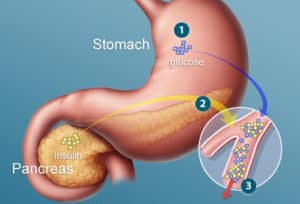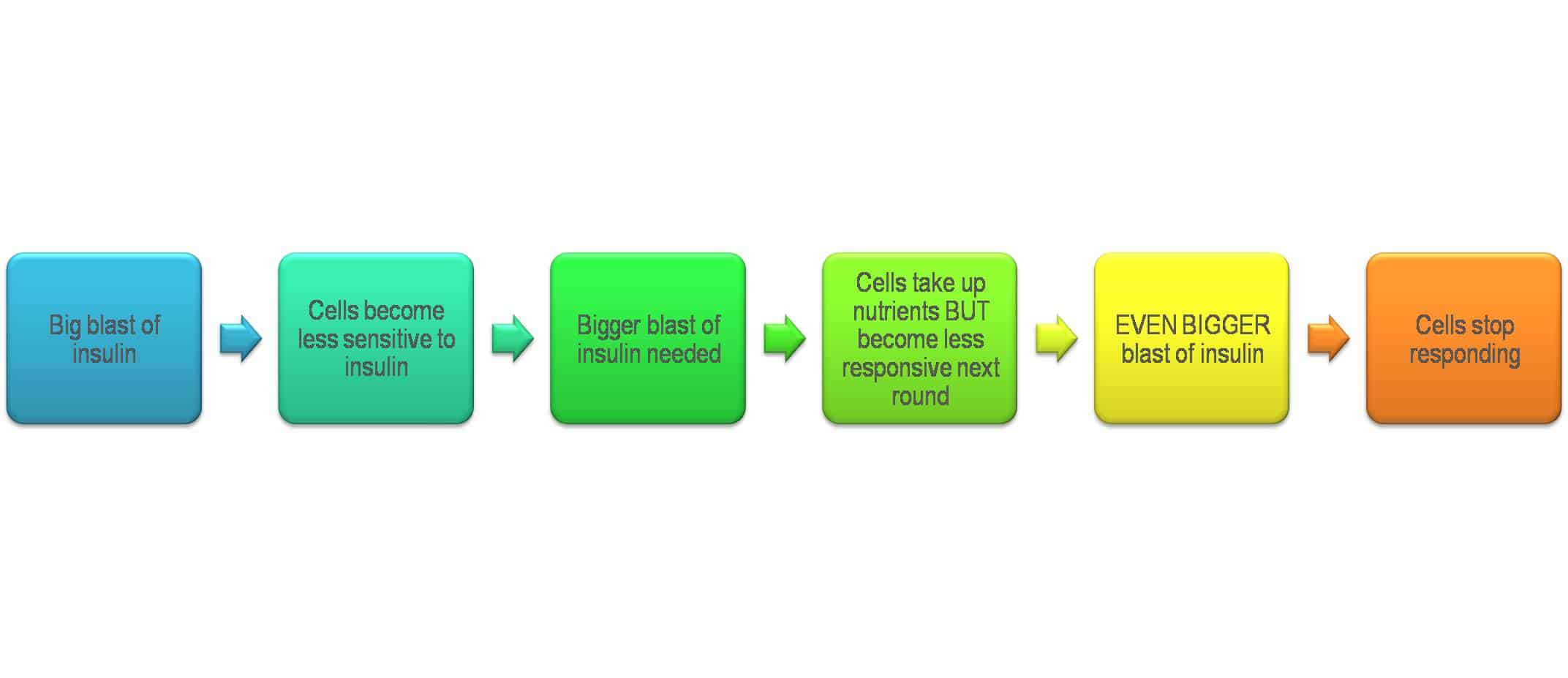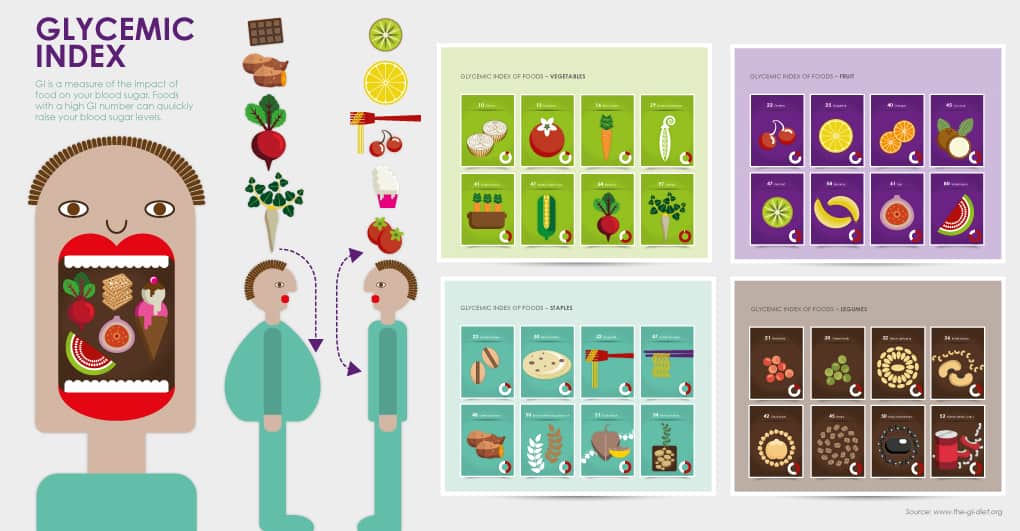By Coach Jen Li Sheng, Genesis Gym Eunos Centre Manager
We’ve previously touched on hormones and how it can affect our lives. Let’s zoom in on one of the more crucial ones today, and how it can affect our health and fitness goals.
What is Insulin? And What Exactly Does it Do?
Insulin is a hormone produced in our pancreas. Whenever we ingest food, an abundance of nutrients starts to build up in our blood stream. The pancreas then pumps out insulin, as a “messenger” to tell our cells to open up and receive these nutrients from the blood. Having too much nutrients left in our blood stream can cause ill effects to our bodies. The most commonly known one being diabetes, is where too much glucose or blood sugar is left lingering in the blood, causing damage to cells and body, thus negatively impacting health.

(Image Source: diabetestype1research.blogspot.com)
Important Function #1: Build & Repair
Insulin also signals the body to build and repair. With the presence of insulin, cells absorb nutrients to facilitate growth and recovery. This is important as we go about our daily activities, and especially so when our lives include regular exercise to keep our bodies strong, fit, and healthy. Eating the correct amount and type of foods will facilitate this process. Along with a sound fitness regime, an optimal diet plan is so crucial for our daily functioning and fitness goals. That is how the Genesis Fitness System tailors a detailed holistic programme for every single client.
Important Function #2: Buffer Against Stress
Insulin is also a good buffer against cortisol - the stress hormone that is so prevalent in modern society. Having too much cortisol breaks down our bodies and encourages fat gain in the mid section, i.e. belly fat. That is why, for highly stressed client at Genesis Gym Singapore, we recommend carbohydrate consumption post-workout. Carbohydrates, being the most potent macronutrient to stimulate the production of insulin, will help to bring down cortisol in our bodies and curb its effects.
As you can see, having enough insulin is important. But as with most things in life, it is possible to have too much of a good thing.
The Problem with Too Much Insulin
Ideally, when we clear the nutrients from our blood stream, we want them to go mainly towards our muscles. Being the “engines” in our body, they utilize the nutrients for energy, recovery and growth. However, we only have a limited amount of muscle. If there is still a lot of nutrients left in our blood after our muscles are filled up, the pancreas will have to continue to pump out more insulin to clear away the remaining nutrients. Guess where these will end up eventually?
Yes, your fat cells.
After muscles and organs have had their fill, the remaining nutrients have to be stored away. Unlike muscle, our body can reproduce more fat cells effortlessly. They can also readily expand in size, increasing in capacity, so it is simply easier to shuttle all excess nutrients into storage as fat.
Think of this situation as how a hoarder keeps collecting stuff. There is only so much proper storage space in the form of shelves or cabinets in a house. In order to continue storing more items, it is easier to lay things around living space, stacked on top of each other. Before long, the house starts spilling at its seams. Likewise, constant overconsumption of food will stimulate excessive insulin, telling the body to keep storing nutrients, which in turn will cause fat gain.

Hoarding a little more than we need, are we? (Image Source: fatloserblog.com)
What if we go further down this rabbit hole? What if, after we learn that high insulin levels have it drawbacks, we keep on stimulating its production?
Well, with each exposure to a high blast of insulin, our cells lose a bit of sensitivity to its “message”. Think of someone who constantly nags at you. You would soon tune down and eventually tune out. Our cells respond in the same manner too. So the message to take up nutrients and clear the blood stream does not come across as clearly as before.
However, too much nutrients cannot be left hanging around in the blood stream. It is toxic to the body. In response to this, the body “shouts” louder at our cells. It stimulates more insulin to get the message across. And your body does so using the one way it knows how: by stimulating hunger, so that you eat more food. Sensing even more nutrients in the blood stream, the pancreas produces even more insulin.
Can you see how this can become a problem?

Insulin Resistance - an inability for cells to respond to insulin’s message efficiently
Effects of Insulin Resistance
The degree of insulin resistance in one’s body would likely determine the severity of the effects experienced. Milder consequences include difficulty in recovering from daily activities, as uptake of nutrients is crucial for cells to recover and grow. Consequently, poor energy levels and tiredness become a constant.
A slightly more severe consequence would be the inability to build muscle and lose fat in an effective manner. Having more insulin than needed halts fat loss, as it is giving out the instruction to the body to be in storage mode.
Even more severe is the diminishing muscle mass and gaining of more fat tissue. As mentioned, it is always easier for the body to store nutrients as fat. Since muscle cells have stopped responding well, the body has to shuttle the nutrients into the easy expanding capacity of fat cells, or produce new fat cells.
Finally, reaching the extreme end would be Type II diabetes, where the amount of insulin produced by the pancreas is insufficient to make the insulin resistant cells in the body respond and clear nutrients from the blood. All the above physical symptoms are experienced one way or another to some extent at this stage, on top of other medical and physiological implications that comes with the illness.
But we’re not done yet, folks.
Insulin Increases Inflammation in the Body
Inflammation is the body’s way of signalling that a problem has occurred, and needs to be addressed. Remember the last time you dropped a dumbbell onto your toe, and the area started swelling, turning red and being sore? That is inflammation in action. This signals to your body (and you) that your toe needs repair and attention, and begins the body’s natural healing processes.
Although needed to some degree in our bodies, excessive inflammation is bad for us. High levels damage cells and impair normal cellular function. Many modern-day ailments such as cardiovascular diseases, Alzheimer’s, and of course, diabetes, are linked back to chronic high levels of inflammation. Stimulating too much insulin on a regular basis will have an impact on your long-term health, and is definitely not a good idea.
As explained, you put on more body fat because you are insulin resistant. Higher body fat levels in and of itself also increases overall inflammation in your body. And because inflammation causes impairs normal cell function, including that of your muscle cells, this results in even more insulin resistance and predisposes you to even more fat gain. This then becomes a vicious cycle.
All things considered, health, fitness and cosmetic goals included, managing your insulin levels and insulin sensitivity is important, and definitely something you want to do.
7 Important Tips to Increase Insulin Sensitivity
Depending on dietary habits, lifestyle, and body fat composition, our bodies are constantly shifting on this continuum. So what are some practical steps we can pursue to the tilt the balance in our favour?
#1: Don’t eat so much! (or eat less)
This seems like a no-brainer if you are following so far, but being in a slight caloric deficient (eating less than then what your body expends in terms of energy) will increase insulin sensitivity. First of all, there is less food going down the hatch, hence reducing the amount of insulin produced by the body. With overall lowered insulin levels, and nutrients being a bit more scarce than usual, your cells become a little more attentive to insulin’s message again.
Think musical chairs. Everyone becomes a little more alert when one chair there is one chair less.

(Image Source: yourstory.com)
#2: Ensure that there is protein, fiber and fat in every meal
You might have heard of the Glycemic Index, or GI for short. It is the measure of how fast a carbohydrate gets digested and subsequently raises blood sugar levels in the body. The reason why GI has limited applications in certain contexts is partly because of theses 3 foods: protein, fats and fiber.

Glycemic Index of Selected Foods (Image Source: cargocollective.com)
Carbs are rarely consumed in isolation. Whenever a carbohydrate source is consumed with any of these foods, or a combination of them, the glycemic index of the food is lowered. This means that a food that would have previously caused a huge increase in blood sugar level when consumed on its own will impact blood sugar levels less now.
Hence, less insulin is needed to deal with a huge amount of glucose channeled into the blood stream within a short time frame. Therefore, other than just nourishing your body, ensuring that you consume carbs with any of these foods will help to prevent huge spikes of insulin in your body.
A good rule of thumb is to ensure that there is a protein source in every meal you consume. The size of the protein source should be one palm-sized, with the same thickness of your palm. The protein will serve to mitigate a rapid rise in blood sugar, resulting in less insulin being released. It would be even better if there is a fibre source at this meal. A palm-sized serving of veggies, or a piece of fruit would do just fine. Round it off with a serving of healthy fat, and you will not only have a meal that helps to control blood sugar effectively, but is balanced in terms of recovery promoting nutrients.
#3: Exercise!
GLUT 4 transporters are proteins in the body that help to carry glucose from the blood stream into the cells. They usually respond to the call of insulin. Exercise can similarly command these proteins to bring glucose into cells as well, without the help of insulin.
As such, this gives your body another way to clear nutrients from your blood stream, thus giving your cells a break from insulin’s signal, and allowing them to be more sensitive to it in the future. Exercise-induced insulin sensitivity can last up to 16 hours for certain individuals.
Although cardio vascular activities like running, cycling and swimming can increase GLUT4 activity in the body, weight training does have a significant advantage of building more muscle, which brings us to the next point.
#4: Build more muscle
If we liken on bodies to cars, we want the biggest horsepower possible when it comes to the engine. Being able to generate more power would consume more fuel, so having stronger and more muscles ensures that less nutrients stay in the blood. Having more muscle mass is associated with immunity and longevity, so it is more than just a vain pursuit to lift weights. Of course, looking good certainly does not hurt.

Low June Meng, Genesis Gym client
#5: Get lean and stay lean!
The more body fat you have, the more insulin resistant you become.
And the more insulin resistant you are, the more body fat you accumulate. The situation just becomes a never-ending, vicious cycle. That is why to break this cycle, you would need to incorporate change, and introduce at least the first 3 points into your life. Fat loss does encompass other lifestyle factors as well, and that is how we help our clients at our gyms achieve through our systematic coaching.

Michelle Leong, Genesis Gym client
#6: Get adequate and quality sleep
Sleep affects so many aspects of our lives that it is too much to go into detail within a bullet point. But suffice to say, its impact is significant, affecting metabolism, stress levels, and of course, insulin sensitivity.
Imagine being unable to process a quarter of your usual carbohydrate intake properly. That is what 3 days of poor sleep can do to you.
A good night’s sleep will not only help you recover physically, it will help you to remain insulin sensitive. However, with sufficient and restful sleep being a rarity nowadays, try following the steps in Tip #35 of our Ultimate Fitness Guide.
#7 Supplements
While some of these recommended supplements are very effective, we highly encourage you to introduce the prior lifestyle changes first. Incorporated with supplements, the entire approach will serve a synergistic effect for greater results.
- Fish oil: Although commonly known as a supplement, Omega 3s are actually essential fatty acids, integral to health. They cannot be produced in the body, and must be obtained through diet or supplementation. Fish oil increases insulin sensitivity, on top of promoting heart and brain health. Get in 2-3g of EPA and DHA combined, which is the active component of fish oil, every day.
- Magnesium: A mineral that is involved in over 300 processes in the body, one of which is glucose metabolism. Having adequate levels in your body will not only help buffer stress and help you sleep well, but helps manage blood glucose levels too. A typical dose is 200-500mg daily, although this may very from individual to individual. If you start having runny stools, reduce the amount taken.
- Ceylon Cinnamon: Being the variety of cinnamon that helps manage glucose, Ceylon cinnamon is an insulin mimetic, meaning it can exert similar effects on the body like the hormone, but to a lesser extent.
- Berberine: This herbal supplement has studies showing it to be as effective as metformin, a drug given to diabetic patients to increase insulin sensitivity. Plus, it has potent inflammatory and anti-fungal properties too, without the usual side affects of the pharmaceutical drug. 500mg 3 times a day before meals was the dose found to be effective in the study.

(Image Source: ceyloncuisine.com)
Insulin resistance stands for inefficiency, while insulin sensitivity, proper working order and efficacy. You would not stand for the former in real life. Why tolerate it in your body? Try out some of these steps, and see your energy levels rise, your fat levels decrease, and your muscle gains increase. If you need help in these aspects, call us at 93374188 and come for a complimentary consultation with our knowledgeable team of coaches, who will be able to give you sound advice on improving your overall health.
For the month of April, at just $138, get your detailed assessment and one session of customized workout at any one of our 3 Genesis Gym locations.
